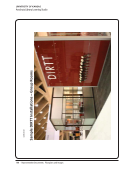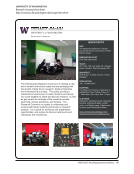SPEC Kit 327: Reconfiguring Service Delivery · 57
We provide one-stop shopping for reference at the main reference desk. We have cross trained the government
documents librarian to provide social sciences and humanities reference and instruction. We are using our professional
staff more efficiently.
We were able to move our librarians to other critical work (creating online learning materials/objects, creating credit
courses, establishing an institutional repository service, pushing out library resources, services, and learning materials to
courses using the campus CMS, assessing the effectiveness of our information resources management, etc.). We were
able to move extremely competent classified staff from areas where work was shrinking (cataloging) into new areas
(reference), avoiding layoffs and keeping their significant knowledge and skills in the institution. We were able to move
responsibility for covering public service points to a single team/unit, resulting in greater efficiency and more consistent
customer service.
17. Please describe up to three unexpected challenges or difficulties that arose as a result of this
service reconfiguration. N=35
A few heavy users of microforms were initially unhappy with the new location of the reader-printers.
A minor problem related to processing of materials that were checked out at the time of the move, but no other
unexpected challenges arose.
Adjusting large number of bibliographic and item records to show new location and loan rules. Determining physical
location and integration of AV materials. Introducing the handling and circulation of AV equipment into Circulation
responsibilities (cameras, batteries, tripods, etc.)
Agreeing on a design: the project requires many different constituencies agreeing on space for staff needs, materials,
and aesthetic issues as well. Funding: building a new service desk is not an incidental cost and our analysis suggested
that in order to create a truly transformative aesthetic experience, a custom, mill-work solution was required. Grant
funding offset the direct cost to some degree, but funding the project is still a large challenge. Staff buy-in: it takes time
for staff who have traditionally worked in different cultures (circulation and reference) to accept and buy into a new
service philosophy. Combining cultures has been a challenge but training and team building has helped this process.
Because we were in transition and moving materials to the new library, we were retrieving our most heavily used
materials on behalf of the users because the stack floors were not yet open.
Challenge: more staff training is needed. This wasn’t unexpected, however.
Cross training of staff. Helping staff adapt to the changes.
Due to the value of certain media in older formats (VHS, DVD), there is a need to keep a number of titles in closed
media. This limits access to some degree. With any non-circulating collection (unavailable for browsing), instructing the
user searching titles in this collection is critical. New demands on circulation.
Having faculty adjust to the new procedures for submitting e-reserve requests for media. Having to staff the desk with
student workers and coming up with a workable staff schedule to support the new service desk. That it was harder than
we expected to get a digital media production unit started.
Here are some difficulties, though not unexpected: Some patrons had a difficult time adjusting to the move of
circulation services from the entrance level. Cross training staff was labor intensive and disruptive, though beneficial.
We provide one-stop shopping for reference at the main reference desk. We have cross trained the government
documents librarian to provide social sciences and humanities reference and instruction. We are using our professional
staff more efficiently.
We were able to move our librarians to other critical work (creating online learning materials/objects, creating credit
courses, establishing an institutional repository service, pushing out library resources, services, and learning materials to
courses using the campus CMS, assessing the effectiveness of our information resources management, etc.). We were
able to move extremely competent classified staff from areas where work was shrinking (cataloging) into new areas
(reference), avoiding layoffs and keeping their significant knowledge and skills in the institution. We were able to move
responsibility for covering public service points to a single team/unit, resulting in greater efficiency and more consistent
customer service.
17. Please describe up to three unexpected challenges or difficulties that arose as a result of this
service reconfiguration. N=35
A few heavy users of microforms were initially unhappy with the new location of the reader-printers.
A minor problem related to processing of materials that were checked out at the time of the move, but no other
unexpected challenges arose.
Adjusting large number of bibliographic and item records to show new location and loan rules. Determining physical
location and integration of AV materials. Introducing the handling and circulation of AV equipment into Circulation
responsibilities (cameras, batteries, tripods, etc.)
Agreeing on a design: the project requires many different constituencies agreeing on space for staff needs, materials,
and aesthetic issues as well. Funding: building a new service desk is not an incidental cost and our analysis suggested
that in order to create a truly transformative aesthetic experience, a custom, mill-work solution was required. Grant
funding offset the direct cost to some degree, but funding the project is still a large challenge. Staff buy-in: it takes time
for staff who have traditionally worked in different cultures (circulation and reference) to accept and buy into a new
service philosophy. Combining cultures has been a challenge but training and team building has helped this process.
Because we were in transition and moving materials to the new library, we were retrieving our most heavily used
materials on behalf of the users because the stack floors were not yet open.
Challenge: more staff training is needed. This wasn’t unexpected, however.
Cross training of staff. Helping staff adapt to the changes.
Due to the value of certain media in older formats (VHS, DVD), there is a need to keep a number of titles in closed
media. This limits access to some degree. With any non-circulating collection (unavailable for browsing), instructing the
user searching titles in this collection is critical. New demands on circulation.
Having faculty adjust to the new procedures for submitting e-reserve requests for media. Having to staff the desk with
student workers and coming up with a workable staff schedule to support the new service desk. That it was harder than
we expected to get a digital media production unit started.
Here are some difficulties, though not unexpected: Some patrons had a difficult time adjusting to the move of
circulation services from the entrance level. Cross training staff was labor intensive and disruptive, though beneficial.






















































































































































































































